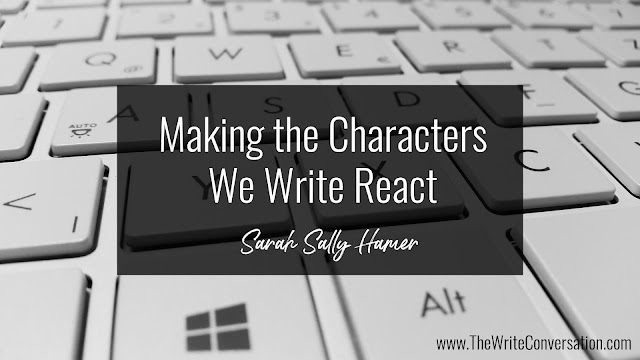by Sarah Sally Hamer @SarahSallyHamer
Characters react. Well, first they have a stimulus of sort, and THEN they react. In fact, characters (and humans) are always in some form of stimulus/reaction or cause/effect or motivation/response mode. Because that’s how story (and life) work. Nothing comes from nothing.
But how do we make our characters react in our stories? I see only half of the equation in so many of the manuscripts that cross my desk that I know it’s just a lack of understanding. Most of the time, writers don’t emphasize the reaction side enough, or they leave it out completely. Or they have a reaction but no great stimulus. And often, I see where they put it in the wrong order. Another problem is that we get a physical reaction but no emotional one. All of these can be easily fixed, once we understand how it works.
Plenty of stimulus but no response—and no emotion—can look like this:
“Tires screeched. A sickening thump told Heather that her dog, who had just escaped from the back yard, had finally met his match.”
Not bad, but it leaves us to wonder not only what happens next but whether or not she cared about the dog. Possible response?
“She gasped and whispered, ‘Oh no!’ under her breath, then raced for the street, knowing, just knowing, that Fluffy was dead.”
First, a visceral reaction, second, a voiced one, then the physical run, and finally, a thought. The visceral reaction—something our bodies do without our thinking about it—should always be first, and the other three can be in any order. Or, you can leave one out, if you don’t want your character to speak, for instance. But now we know for sure she cared and that she’s going to take some sort of action, which starts the whole process again.
Leaving out the stimulus is a little less common, but it still happens. Usually, the problem is that the reaction comes first.
“Heather screamed. The screeching of the tires told her that Fluffy had been hit by a car and was probably dead.”
Do you see the problem? And how awkward that sounds? Yes, we often watch TV shows where we SEE the reaction of a character before we get to see the reason they’re reacting—think horror movies where the character’s reaction sets up the tension, usually right before a commercial, THEN we see the horrible thing when we get back from making popcorn. It can be done successfully and adroitly, but it is much harder to do it in a book. And changing the order is a simple fix.
The beat of stimulus/reaction goes on throughout the entire story. The micro level is in the sentence structure where it’s a matter of “and then THIS happens, which causes THAT, then THIS happens next,” with each set of cause-and-effect units creating the following one.
The macro version is at the scene and chapter level. Each scene or chapter must set up the next one by creating an effect because of the cause in the previous one, with rising and falling tension.
Easy as pie, right? Unfortunately, it can be a little overwhelming. But it is a good tool for your toolbox, and a great way to understand story.
How are your stimulus/reaction units going? Can you see room for improvement?
TWEETABLE
Sarah (Sally) Hamer, B.S., MLA, is a lover of books, a teacher of writers, and a believer in a good story. Most of all, she is eternally fascinated by people and how they 'tick'. She’s passionate about helping people tell their own stories, whether through fiction or through memoir. Writing in many genres—mystery, science fiction, fantasy, romance, medieval history, non-fiction—she has won awards at both local and national levels, including two Golden Heart finals.
A teacher of memoir, beginning and advanced creative fiction writing, and screenwriting at Louisiana State University in Shreveport for almost twenty years, she also teaches online for Margie Lawson at www.margielawson.com. Sally is a free-lance editor and book coach at Touch Not the Cat Books, with many of her students and clients becoming successful, award-winning authors.
You can find her at hamerse@bellsouth.net or www.sallyhamer.blogspot.com
From Sally: I wish to express gratitude to the giants upon whose shoulders I stand and who taught me so much about the writing craft. I would list every one, if it were only possible.


Thanks for this outstanding post, Sarah! I think that the cause-effect aspect of fiction writing is one that needs to be addressed more often, and you've done it brilliantly.
ReplyDeleteI agree it's important! Thanks for the post.
DeleteSally always has the best advice!
ReplyDeleteThank you, Donna! I miss seeing you -- hope you and yours are doing well!
DeleteThank you, Donna! I miss seeing you and hope you are doing well.
ReplyDelete